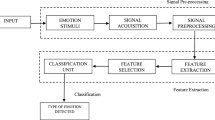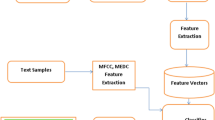Abstract
Social psychologists have long studied job interviews with the aim of knowing the relationships between behaviors, interview outcomes, and job performance. Several companies give great importance to psycho-test based on observation of the candidate is behavior more than the answers they even especially in sensitive positions like trade, marketing, investigation, etc. Our work will be a combination between two interesting topics of research in the last decades which are social psychology and affective computing. Some techniques were proposed until today to analyze automatically the candidate is non verbal behavior. This paper concentrates in body gestures which is an important non-verbal expression channel during affective communication that is not very studied in comparison to facial expressions. We proposed in this work a deep Spatio-temporal approach, it merges the temporal normalization method which is the energy binary motion information (EBMI) with deep learning based on stacked auto-encoder (SAE) for emotional body gesture recognition in job interview and the results prove the efficiency of our proposed approach.
Access this chapter
Tax calculation will be finalised at checkout
Purchases are for personal use only
Similar content being viewed by others
References
Afdhal, R., Ejbali, R., Zaied, M.: Emotion recognition using the shapes of the wrinkles. In: The 19th international Conference on Computer and Information Technology ICCIT (2016)
Mehrabian, A.: Communication without words. Psychol. Today 4, 53–56 (1968)
Nguyen, L.S., Frauendorfer, D., Mast, M., Gatica-Perez, D.: Computational inference of hirability in employment interviews based on non verbal behavior. IEEE Trans. Multimed. 16, 1018–1031 (2014)
Wang, W., Enescu, V., Sahli, H.: Adaptive real-time emotion recognition from body movements. ACM Trans. Interact. Intell. Syst. 5, 18 (2015)
Abrilian, S.: Représentation de Comportements Emotionnels Multimodaux Spontanés: Perception, Annotation et Synthès., Thèse en informatique de l’Université Paris (2007)
Liang, H., Zhao, Y., Wei, J., Quan, D., Cheng, R., Wei, Y.: Robust hand detection and tracking based on monocular vision. In: IEEE International Conference on Intelligent Human-Machine Systems and Cybernetics (2014)
Bouchrika, T., Zaied, M., Jemai, O., Amar, C.B.: Neural solutions to interact with computers by hand gesture recognition. Multimed. Tools Appl. 72, 2949–2975 (2014)
Khalifa, I., Ejbali, R., Zaied, M.: Hand motion modeling for psychology analysis in job interview using optical flow-history motion image (OF-HMI). In: The 10th International Conference on Machine Vision ICMV (2018)
de Gelder, B.: Why bodies? twelve reasons for including bodily expressions in affective neuroscience. Philos. Trans. Roy. Soc. B: Biol. Sci. 364, 3475–3484 (2009)
Kipp, M.: Gesture Generation by Imitation From Human Behavior to Computer Character Animation. Dissertation.com, Boca Raton (2004)
Ekman, P., Friesen, W.V.: The repertoire of nonverbal behavior: categories, origins, and coding. Semiotica 1, 49–98 (1969)
McNeill, D.: Gesture and Thought. The university of Chicago Press books, Chicago (2005)
Burgoon, J.K., Jensen, M.L., Meservy, T.O., Kruse, J., Nunamaker, J.F.: Augmenting human identification of emotional states in video. In: International Conference on Intelligent Data Analysis (2005)
Coulson, M.: Attributing emotion to static body postures: recognition accuracy, confusions, and viewpoint dependence. J. Nonverbal Behav. 39, 117–139 (1992)
Gunes, H., Piccardi, M.: A bimodal face and body gesture database for automatic analysis of human nonverbal affective behavior. In: The 18th International Conference on Pattern Recognition ICPR (2006)
Savva, N., Bianchi-Berthouze, N.: Automatic recognition of affective body movement in a video game scenario. In: Camurri, A., Costa, C. (eds.) INTETAIN 2011. LNICST, vol. 78, pp. 149–159. Springer, Heidelberg (2012). https://doi.org/10.1007/978-3-642-30214-5_17
Chen, S., Tian, Y., Liu, Q., Metaxas, D.N.: Recognizing expressions from face and body gesture by temporal normalized motion and appearance features. J. Image Vis. Comput. 3, 175–185 (2013)
Gunes, H., Piccardi, M.: Automatic temporal segment detection and affect recognition from face and body display. IEEE Trans. Syst. Man Cybern. 39, 64–84 (2009)
Gunes, H., Piccardi, M.: Bi-modal emotion recognition from expressive face and body gestures. J. Netw. Comput. Appl. 30, 1334–1345 (2007)
Kumthekar, A.V., Patil, J.K.: Key frame extraction using color histogram method. Int. J. Sci. Res. Eng. Technol. 2, 207–214 (2013)
Shi, Y., Yang, H., Gong, M., Liu, X., Xia, Y.: Fast and robust key frame extraction method for video copyright protection. J. Electr. Comput. Eng. 3, 1–17 (2017)
Liang, B., Zheng, L.: Gesture recognition from one example using depth images. J. Lect. Notes Softw. Eng. 1, 339–343 (2013)
Hassairi, S., Ejbali, R., Zaied, M.: Supervised image classification using deep convolutional wavelets network. In: 27th International Conference on Tools with Artificial Intelligence ICTAI (2016)
Hassairi, S., Ejbal, R., Zaied, M.: A deep convolutional neural wavelet network to supervised Arabic letter image classification. In: 15th International Conference on Intelligent Systems Design and Applications ISDA (2015)
Acknowledgment
The authors would like to acknowledge the financial support of this work by grants from General Direction of Scientific Research (DGRST), Tunisia, under the ARUB program.
Author information
Authors and Affiliations
Corresponding author
Editor information
Editors and Affiliations
Rights and permissions
Copyright information
© 2019 Springer Nature Singapore Pte Ltd.
About this paper
Cite this paper
Khalifa, I., Ejbali, R., Zaied, M. (2019). Body Gesture Modeling for Psychology Analysis in Job Interview Based on Deep Spatio-Temporal Approach. In: Park, J., Shen, H., Sung, Y., Tian, H. (eds) Parallel and Distributed Computing, Applications and Technologies. PDCAT 2018. Communications in Computer and Information Science, vol 931. Springer, Singapore. https://doi.org/10.1007/978-981-13-5907-1_29
Download citation
DOI: https://doi.org/10.1007/978-981-13-5907-1_29
Published:
Publisher Name: Springer, Singapore
Print ISBN: 978-981-13-5906-4
Online ISBN: 978-981-13-5907-1
eBook Packages: Computer ScienceComputer Science (R0)




